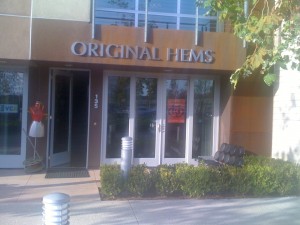 Here in Orange County, CA we’ve finally begun to buck urban sprawl with “urban living” apartments —
Here in Orange County, CA we’ve finally begun to buck urban sprawl with “urban living” apartments —
buildings with rows of shops on the ground floor beneath loft apartments. I want to tell you about the tailor I found who has set up shop in one of those buildings. It’s the Original Hems Studio across from the Main Place Mall, and they are remarkable for two things: while-you-wait service and convenient hours — two aspects of business that support each other.
As a customer, I find that these are drastic simplifications over the tailor shop I was using before. My old tailor was only open until 6:00 on weekdays plus a few hours on Saturdays, and it was hard for me to schedule in my stops. OHS, on the other hand, is open until 9pm every weekday, and for 10 hours on Saturday and another 7 on Sunday. OHS’s while-you-wait service also means that I only have to schedule one visit into my calendar, not two.
In order to provide such service, the owner of OHS has to spend a lot. It takes a lot of equipment and a big staff to support peak periods of random walk-ins. Multiply that by the extended hours and we’re talking about a big payroll. This means, for one thing, keeping a watchful eye on traffic patterns and tightly controlling those staff schedules. It also means having to be creative with excess capacity by soliciting corp-to-corp business which does not require while-you-wait service.
OHS started out with shorter hours, closing 2 hours earlier each day than they do today. They obviously identified a pattern where customers were rushing in at the last minute and the staff would have to stay late to accommodate them. Their brilliance was in making the extended hours official. That took away the rushing on the customers’ part, and it took away the staying-late on the staff’s part. Customers could count on not being turned away and staff could count on going home when officially scheduled.
There are many additional Pros to while-you-wait service:
- Instant gratification is always nice.
- Less storage space is required when items are only in your shop for less than an hour.
- Less liability for lost/stolen/damaged items — it’s harder to lose items if they are only in your shop for less than an hour, and it’s harder to forget the tailoring instructions if they are fresh in your mind.
- Eliminating the second trip not only saves customers’ time, but also saves them gas, so you get kudos for being “green.”
- The need to provide a well-appointed, well-styled waiting room means more for customers to buzz about.
- The need to be creative and solicit business to fill in between peak demands means more profit.
So, this is a prime example of deciding who’s lives are most important to simplify — the retail customers? the corporate customers? the owners and managers? the staff? the vendors? — and then designing your systems with that answer in mind.